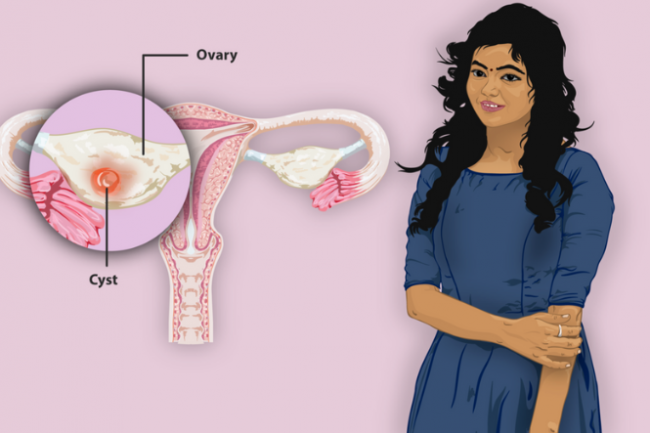Ovarian cysts
Key points about ovarian cysts
- An ovarian cyst is a fluid-filled sac that develops inside an ovary.
- Most ovarian cysts are noncancerous (benign), cause no symptoms and will often go away without treatment. Some (less than 5%), cause problems such as pain and irregular bleeding.
- Ovarian cysts can vary in size, from less than the size of a pea to the size of a large melon (occasionally even larger).
- They are very common and can develop at any age. They occur more often in younger women who have not reached menopause but can also occur after menopause.

Below is a video about ovarian cysts and the symptoms they can cause, the long-term effects and the treatment options. Click the image below and scroll to the bottom of the page to play video.
Video: ovarian cysts
This video may take a few moments to load.
 (external link)
(external link)
(NHS, UK, 2018)
There are 2 main types of cysts – functional cysts and pathological cysts.
Functional cysts
- These are the most common type.
- They are harmless cysts that form during the menstrual cycle or periods.
- They produce hormones, so periods can be delayed and irregular.
- These cysts often have no symptoms or mild symptoms and go away in 1 to 3 months.
- They only require removal if they are causing severe pain, or do not go away.
Pathological cysts
- These are tumours in the ovaries that are either benign (harmless) or malignant (cancerous). These cysts continue to grow until they are removed.

Image credit: Myupchar wikimedia
The most common causes of ovarian cysts include:
- Hormonal problems
- Functional cysts usually go away on their own without treatment. They may be caused by hormonal problems or by drugs used to help you ovulate.
- Endometriosis
- Endometriosis happens when tissue similar to that lining the uterus (womb) grows outside the uterus. The endometriosis tissue may attach to the ovary and form a growth (endometrioma). These cysts can be painful during sex and during your period.
- Pregnancy
- An ovarian cyst normally develops in early pregnancy to help support the pregnancy until the placenta forms. Sometimes, the cyst stays on the ovary until later in the pregnancy and may need to be removed.
- Severe pelvic infections
- Infections can spread to the ovaries and fallopian tubes and cause cysts (abscesses) to form.
Polycystic ovarian syndrome doesn't cause ovarian cysts
Polycystic ovarian syndrome (PCOS) and ovarian cysts are 2 different conditions that are often confused. It's important to know that polycystic ovary syndrome doesn't cause ovarian cysts.
PCOS is a metabolic disorder associated with hormonal imbalance, excess androgen production and ovulation problems.
Read more about polycystic ovarian syndrome.
Most ovarian cysts don't cause symptoms, but in a few women they may cause symptoms such as:
- Pain in the tummy area (abdomen or pelvis), especially during your period or during intercourse.
- Irregular periods that may become lighter or heavier than usual.
- Problems with urination or bowel movements.
- Weight gain.
Sometimes, ovarian cysts may rupture, twist, bleed or become infected, all of which are likely to cause severe pain and may cause nausea and vomiting. Rupture of a cyst often occurs after exercise, sexual intercourse, trauma or even a pelvic examination.
| You should seek immediate medical attention if you have: |
|---|
|
Ovarian cysts and fertility
Ovarian cysts don't usually affect a person's ability to get pregnant – even if the cyst is large enough to require removal. This is usually done using a special type of surgery called laparoscopy (using ‘keyhole’ surgery), which does not affect your fertility.
If your healthcare provider suspects that you have an ovarian cyst, they may send you for tests including:
- An ultrasound scan to see where and how big the cyst is.
- A pregnancy test to rule out pregnancy.
- A hormone level test to see whether there are hormone-related problems.
- If you are past menopause, your doctor may give you a test to measure the amount of cancer-antigen 125 (CA-125) in your blood. The amount of CA-125 is higher with ovarian cancer. In premenopausal women, many other illnesses or diseases besides cancer can cause higher levels of CA-125.
The treatment of ovarian cysts depends on your age, the type and size of your cyst, and your symptoms. Your healthcare provider may suggest:
No treatment (also called watchful waiting)
No treatment is usually an option, regardless of your age, if you have no symptoms and an ultrasound shows you have a small, fluid-filled cyst. However, you will be monitored for any changes in symptoms and changes in the size of the cyst.
Birth control pills
Your doctor may recommend birth control pills (also called oral contraceptives) to reduce the chance of new cysts developing in future menstrual cycles. Also, oral contraceptives are known to reduce your chance of ovarian cancer – the risk decreases the longer you take birth control pills.
Surgery
An operation or surgery may be performed to remove the cyst if it is large, it is growing, or it does not go away within a few months. Cysts that cause pain or other symptoms may be removed.
The following links provide further information on ovarian cysts. Be aware that websites from other countries may contain information that differs from New Zealand recommendations.
Ovarian cysts(external link) Auckland District Health Board, NZ
Ovarian cyst(external link) Patient.info.uk
Ovarian cysts Saint Mary's Hospital, NHS, UK
Apps
References
Credits: Healthify editorial team. Healthify is brought to you by Health Navigator Charitable Trust.
Reviewed by: Dr Zoe LaHood, Senior House Officer, Hutt Valley DHB, NZ
Last reviewed:
Page last updated:





